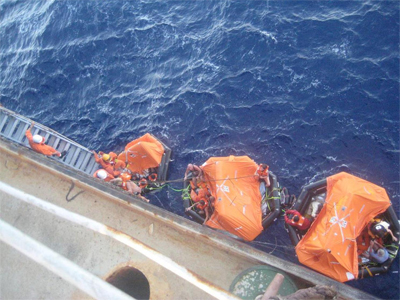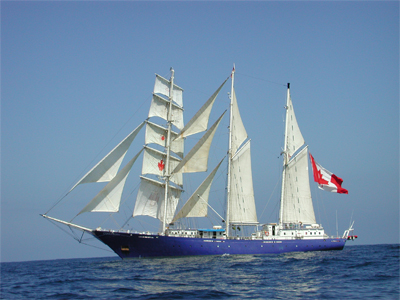The capsizing of a Nova Scotia-based sail training vessel off Brazil two years ago was due to a failure of the watchkeeper's understanding of the risk of a knockdown, the Transportation Safety Board (TSB) of Canada said.
 |
|
Concordia's life rafts come alongside one of the ships. (Photo courtesy Mitsui OSK Lines) |
All 64 occupants of Concordia were rescued after the 188-foot sailing ship blew over onto its side with its masts in the water Feb. 17, 2010, about 300-nm southeast of Rio de Janeiro.
In a September 2011 report, the TSB said the accident reveals a need for mandatory stability training.
"The TSB found the sail training vessel Concordia was lost in a squall because the risk of a knockdown was not understood," said board member Jonathan Seymour. "Consequently, appropriate action — such as reducing sail or changing course — was not taken before the squall hit. With doors, windows and vents left open, water flooded into the hull and the vessel capsized."
"Every watchkeeper must understand how their vessel will behave in deteriorating weather," Seymour said.
The board's investigation identified two important safety issues. Canadian sail training vessels are required to have comprehensive stability guidance on board, but there is no requirement for watchkeepers to be trained in its use. The first recommendation is for mandatory training.
 |
|
Concordia hosted a Class Afloat program before capsizing in 2010. Merchant ships Hokuetsu Delight and Crystal Pioneer rescued all 64 who had been aboard. (Photo courtesy West Island College International) |
Because sail training is international in scope, the board's second recommendation is for Transport Canada to lead the way towards international standards for stability guidance and training. Unlike Canada, some jurisdictions do not require comprehensive stability guidance.
The 64 crew, faculty and students successfully abandoned the vessel into life rafts. They were rescued two days later by two merchant vessels and taken to Rio de Janeiro.
West Island College International Inc., owners of Concordia, rejects many of the TSB's conclusions. The college argues that the TSB did not accurately report the weather conditions of Feb. 17, 2010. It disagrees with the TSB's assertion that Concordia was knocked down by a conventional convective squall.
In a statement to Professional Mariner, Terry Davies, spokesman for West Island College, said the investigation report did not faithfully include the whole of the reports and conclusions provided by experts at Environment Canada and the U.S.'s National Oceanic and Atmospheric Administration (NOAA).
"In failing to do so, the Transportation Safety Board of Canada has presented misleading conclusions and has even missed an opportunity to advocate for improved marine weather forecasting services, and specifically upper-level atmospheric conditions that are known to cause microbursts," Davies wrote.
The college insists that a microburst knocked Concordia down.
"Mr. Ken Pryor of NOAA, respected meteorologist and noted microburst researcher, says that there is no doubt that the Concordia was struck by a microburst," Davies wrote. "The vessel was in the specific area where conditions were specifically conducive to microburst activity."
The college said it supports the TSB recommendations, but it rejected the assertion that the officers did not understand the risks of a knockdown. The true issue, the college said, was not foreseeing or understanding the risks of a microburst.
The college also rejects the TSB's assertion the officers did not understand the stability guidance information that was in Concordia's stability booklet. The booklet contains no guidance or models for heeling arms and righting moments influenced by vertical wind components.
The TSB said previous knockdown occurrences have highlighted the need for advance preparation or training. The report noted that Concordia was in full compliance with the requirements regarding equipment and drills, and significantly exceeded requirements for life-raft capacity. But the report identified numerous safety deficiencies.
The communications equipment could not be accessed as the chart room flooded quickly. Three of eight life rafts were submerged and thus inaccessible. A fourth was damaged following deployment. The evacuees had difficulty releasing and boarding the remaining four life rafts.
The rescue boat stowed atop the mess fell upside down in the water due to the large angle of heel, rendering it useless. Certain members of the complement had difficulty orienting themselves following the knockdown. The second officer did not completely seal his immersion suit, and it filled with water when he became submerged. The members of the complement assigned to check cabins did not do so, and the doors that were positioned overhead became difficult to access or open.
The TSB said the vessel did not have specific plans or practices in place to deal with possible knockdowns. The aft classroom had no portside door to the exterior.
Had the vessel capsized to starboard, escape would have been significantly more difficult for those inside the escape hatches in the aft classroom and mess.
The college's statement said the TSB has missed an excellent opportunity to address more urgent safety deficiencies and that the college was at a loss to explain the rejection of the microburst theory.
